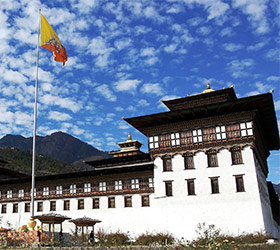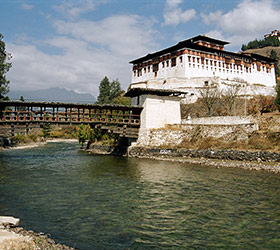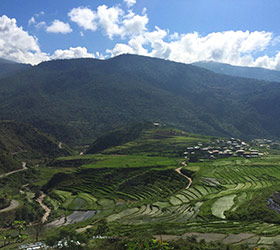Bhutan
All Destinations
Bhutan
With a sophisticated and well preserved culture, the Kingdom of Bhutan has a draw like few others. Images of a country can often mislead – glamorous films, angled photography or old pictures. Bhutan, however, doesn’t disappoint.
Rolling velvet hills meander up to the distant snowy peaks of the various Himalayan ranges. Passionate about their cultural history and identity, the Bhutanese have fought to maintain the integrity and individuality of their unique nation, so much so even the airport is a thing of beauty.
Guiding is the key in a country where the emphasis is less on ticking off ‘must-sees’ and more on stumbling upon the odd local festival or archery contest. The best guides will know when to take you where, and will take pride in showing you the places others don’t go.
Quick Facts
Capital
Thimphu
Population
750,000
Area
38,364 sq km (14,812 sq miles)
Major Languages
Dzongkha
Major religion
Buddhism (official), Hinduism
Monetary Unit
ngultrum
Flight time from London
10hrs + transit
Time Difference
GMT +6
When to go
Climatic conditions within Nepal vary from one place to another in accordance with the geographical features. In the north, summers are cool and winters severe, while in the south summers are sub-tropical and winters mild. The monsoon that brings rain from June through September affects most of the country except those that lie in the rain-shadow areas like Mustang which is within Nepal but a part of the Tibetan plateau.
The climate changes rapidly from the sub-tropical terai to the cool dry temperate and alpine conditions in the northern Himalayan ranges within a short span of 200 km. In the terai, which is the hottest part of the country, summer temperatures rise above 45°C. The climate here is hot and humid. In the middle hills, the summer climate is pleasant with temperatures around 25°C – 27°C.
The winter temperatures range from 7°C to 23°C in the terai and sub-zero to 12°C in the mountainous regions, hills and valleys. The northern Himalayan region has an alpine climate with temperatures reaching below -30°C. The valley of Kathmandu has a pleasant climate with an average summer and winter temperatures of 19°C – 27°C and 2°C – 12°C respectively.
- J
- F
- M
- A
- M
- J
- J
- A
- S
- O
- N
- D
- High Season
- Mid Season
- Shoulder Season
Highlights





Thimphu
The Kingdom’s capital city is home to approximately 100,000 inhabitants including the Royal family. This bustling little city is the main centre of commerce, religion and government in the country. The juxtaposition of ancient tradition and modernity make Thimphu the ideal location for visitors to break away from their tour itinerary to immerse themselves in the contemporary Bhutanese lifestyle.
Thimphu is the most modern city in Bhutan with an abundance of restaurants, internet cafes, nightclubs and shopping centres. However, it still retains its’ cultural identity and values amidst the signs of modernization. Thimphu is one of the few towns in Bhutan that have been equipped with ATM banking facilities and is a good place to stock up on some currency.
There are several attractions in Thimphu such as the National Post Office, the Clock Tower Square, the Motithang Takin Preserve, Tango and Chari Monasteries, Buddha Dordenma, National Memorial Chorten, Centenary Farmer’s Market, Semtokha Dzong to name a few. These form the most important tourist attractions in the capital city.
The culture of Bhutan is fully reflected in Thimphu in respect of religion, customs, national dress code, the monastic practices of the monasteries, music, dance, literature and the media. Tshechu is an important festival where mask dances, popularly known as Chams, are performed in the courtyards of the Tashichho Dzong in Thimphu. It is a four-day festival held every year during autumn (September/October), on dates corresponding to the Bhutanese calendar. One of the most curious features of Thimphu is that it is the only capital city in the world that does not use traffic lights. Instead, a few major intersections have policemen standing in elaborately decorated booths (small pavilions), directing traffic with exaggerated hand motions.





Paro
Paro valley extends from the confluence of the Paro Chhu and the Wang Chhu rivers at Chuzom up to Mt. Jomolhari at the Tibetan border to the North. This picturesque region is one of the widest valleys in the kingdom and is covered in fertile rice fields and has a beautiful, crystalline river meandering down the valley.
Accentuating the natural beauty are the elegant, traditional-style houses that dot the valley and surrounding hills. One of the distinctive features of Paro town is that it is situated in a flat valley bottom and follows a grid-like pattern. The central plaza is adorned with a large prayer wheel and a small amphitheater where events are held throughout the year.
There are over 155 temples and monasteries in the area, some dating as far back as the 14th century. The country’s first and only international airport is also located in the region. Its close proximity to the historical and religious sites in the region has resulted in the development of an array of luxurious, high-end tourist resorts making Paro one of the main destination for visitors.
The region contains one of Bhutan’s most iconic landmark, Taktsang Monastery, the Tiger’s Nest. This awe-inspiring temple was constructed upon a sheer cliff face, above forests of oak and rhododendrons. The national museum, Ta Dzong, is also set in Paro. An ancient watchtower that displays hundreds of ancient Bhutanese artefacts and artwork including traditional costumes, armour, weaponry and handcrafted implements for daily life. The collection at the National Museum preserves a snap-shot of the rich cultural traditions of the country. Another site worth visiting in Paro is Drugyel Dzong or The Fortress of the Victorious Bhutanese. It was constructed by Zhabdrung Ngawang Namgyal in 1646 to commemorate his victory over marauding Tibetan armies. The fortress was destroyed by fire in 1951 but the ruins remain an impressive and imposing sight.






Punakha
Punakha Dzongkhag has been inextricably linked with momentous occasions in Bhutanese history. It served as the capital of the country from 1637 to 1907 and the first national assembly was hosted here in 1953. Punakha Dzong is not only the second oldest and second largest dzong but it also has one of the most majestic structures in the country.
October 13, 2011 marked an unforgettable wedding of the King of Bhutan, Jigme Khesar Namgyel Wangchuck to Jetsun Pema which was held at Punakha Dzong. Punakha Dzong was built at the confluence of two major rivers in Bhutan, the Pho Chhu and Mo Chhu, which converge in this valley. It is an especially beautiful sight on sunny days with sunlight reflecting off the water onto its white-washed walls.
In addition to its structural beauty, Punakha Dzong is notable for containing the preserved remains of Zhabdrung Ngawang Namgyal, the unifier of Bhutan as well as a sacred relic known as the Ranjung Karsapani. This relic is a self-created image of Avalokiteswara that miraculously emerged from the vertebrae of Tsangpa Gyarey, the founder of the Drukpa School when he was cremated.
Punakha valley has a pleasant climate with warm winters and hot summers. It is located at an average elevation of 1200 m above sea level. Owing to the favourable climatic conditions, rice has become the main cash crop cultivated in the region.





Thimphu
The Kingdom’s capital city is home to approximately 100,000 inhabitants including the Royal family. This bustling little city is the main centre of commerce, religion and government in the country. The juxtaposition of ancient tradition and modernity make Thimphu the ideal location for visitors to break away from their tour itinerary to immerse themselves in the contemporary Bhutanese lifestyle.
Thimphu is the most modern city in Bhutan with an abundance of restaurants, internet cafes, nightclubs and shopping centres. However, it still retains its’ cultural identity and values amidst the signs of modernization. Thimphu is one of the few towns in Bhutan that have been equipped with ATM banking facilities and is a good place to stock up on some currency.
There are several attractions in Thimphu such as the National Post Office, the Clock Tower Square, the Motithang Takin Preserve, Tango and Chari Monasteries, Buddha Dordenma, National Memorial Chorten, Centenary Farmer’s Market, Semtokha Dzong to name a few. These form the most important tourist attractions in the capital city.
The culture of Bhutan is fully reflected in Thimphu in respect of religion, customs, national dress code, the monastic practices of the monasteries, music, dance, literature and the media. Tshechu is an important festival where mask dances, popularly known as Chams, are performed in the courtyards of the Tashichho Dzong in Thimphu. It is a four-day festival held every year during autumn (September/October), on dates corresponding to the Bhutanese calendar. One of the most curious features of Thimphu is that it is the only capital city in the world that does not use traffic lights. Instead, a few major intersections have policemen standing in elaborately decorated booths (small pavilions), directing traffic with exaggerated hand motions.





Paro
Paro valley extends from the confluence of the Paro Chhu and the Wang Chhu rivers at Chuzom up to Mt. Jomolhari at the Tibetan border to the North. This picturesque region is one of the widest valleys in the kingdom and is covered in fertile rice fields and has a beautiful, crystalline river meandering down the valley.
Accentuating the natural beauty are the elegant, traditional-style houses that dot the valley and surrounding hills. One of the distinctive features of Paro town is that it is situated in a flat valley bottom and follows a grid-like pattern. The central plaza is adorned with a large prayer wheel and a small amphitheater where events are held throughout the year.
There are over 155 temples and monasteries in the area, some dating as far back as the 14th century. The country’s first and only international airport is also located in the region. Its close proximity to the historical and religious sites in the region has resulted in the development of an array of luxurious, high-end tourist resorts making Paro one of the main destination for visitors.
The region contains one of Bhutan’s most iconic landmark, Taktsang Monastery, the Tiger’s Nest. This awe-inspiring temple was constructed upon a sheer cliff face, above forests of oak and rhododendrons. The national museum, Ta Dzong, is also set in Paro. An ancient watchtower that displays hundreds of ancient Bhutanese artefacts and artwork including traditional costumes, armour, weaponry and handcrafted implements for daily life. The collection at the National Museum preserves a snap-shot of the rich cultural traditions of the country. Another site worth visiting in Paro is Drugyel Dzong or The Fortress of the Victorious Bhutanese. It was constructed by Zhabdrung Ngawang Namgyal in 1646 to commemorate his victory over marauding Tibetan armies. The fortress was destroyed by fire in 1951 but the ruins remain an impressive and imposing sight.






Punakha
Punakha Dzongkhag has been inextricably linked with momentous occasions in Bhutanese history. It served as the capital of the country from 1637 to 1907 and the first national assembly was hosted here in 1953. Punakha Dzong is not only the second oldest and second largest dzong but it also has one of the most majestic structures in the country.
October 13, 2011 marked an unforgettable wedding of the King of Bhutan, Jigme Khesar Namgyel Wangchuck to Jetsun Pema which was held at Punakha Dzong. Punakha Dzong was built at the confluence of two major rivers in Bhutan, the Pho Chhu and Mo Chhu, which converge in this valley. It is an especially beautiful sight on sunny days with sunlight reflecting off the water onto its white-washed walls.
In addition to its structural beauty, Punakha Dzong is notable for containing the preserved remains of Zhabdrung Ngawang Namgyal, the unifier of Bhutan as well as a sacred relic known as the Ranjung Karsapani. This relic is a self-created image of Avalokiteswara that miraculously emerged from the vertebrae of Tsangpa Gyarey, the founder of the Drukpa School when he was cremated.
Punakha valley has a pleasant climate with warm winters and hot summers. It is located at an average elevation of 1200 m above sea level. Owing to the favourable climatic conditions, rice has become the main cash crop cultivated in the region.
Where to stay
These are just a selection of the properties we can personally recommend. Please get in touch to hear more about our full portfolio.
Amankora Punakha Lodge
Reached via a suspension bridge over the Mo Chhu River, the Amankora Punakha Lodge incorporates a traditional Bhutanese farmhouse built by a former Je Khenpo (chief abbot of Bhutan).
COMO Uma Paro
COMO Uma Paro, is an intimate, 29-room resort featuring the most exclusive private villas in Bhutan with an enviable location in the Paro Valley.
Taj Tashi
Discover a land of mythology and magic at Taj Tashi, nestled in the folds of the magnificent Thimphu Valley.
Get in touch with us to start planning your journey
Follow Us
Proudly ASSOCIATED WITH










